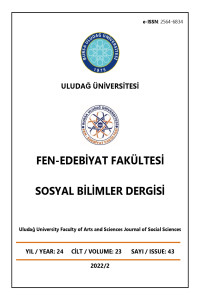Öz
Anahtar Kelimeler
zaman algısı bağlam etkisi aşinalık etkisi video izleme psikolojik zaman
Kaynakça
- Appelman, I. B. & Mayzner, M. S. (1981). The letter-frequency effect and the generality of familiarity effects on perception. Perception & Psychophysics 30(5), 436-446.
- Avant, L. L., Lyman, P. J., Antes, J. R. (1975). Effects of stimulus familiarity upon judged visual duration. Perception & Psychophysics 17(3), 253-262.
- Balcı, F. & Karşılar, H. (2016). Asymmetrical modulation of time perception by increase vs. decrease in coherence of motion. Attention, Perception & Psychophysics, 78(8), 2690-2707.
- Barlett, C., Branch, O., Rodeheffer, C., Harris, R. (2009). How long do the short-term violent video game effects last? Aggressıve Behavior, (35), 225-236.
- Buhusi, C. V. & Meck, W. H. (2005). What makes us tick? Functional and neural mechanisms of interval timing. Nature reviews. Neuroscience, 6(10), 755-765.
- Buonomano, D. (2019). Beyniniz bir zaman makinesi. (Çev: Y. Konyalı), Timaş Yayınları.
- Draaisma, D. (2008). Why life speeds up as you get older: how memory shapes our past. Cambridge University Press, 310-325.
- Guyau, J. M. (1890). The origin of the idea of time. (Çev: J. A. Michon, V. Pouthas, C. Greenbaum in J. A. Michon, V. Pouthas, J. L. Jackson), Felix.
- Holz, E. (2002). Time stres and time srunch in the daily life of women, men and families. International Time Use Conferences içinde (135-139. ss.), Kitchener-Waterlooi Kanada.
- Irvy, R. (2008). The representation of temporal information in perception and motor control. Current Opinion in Neurobiology 6, 851-857.
- Klein, S. (2011). Yaşamın hammaddesi zaman bir kullanma kılavuzu. (Çev: M. Tüzel), Aylak Kitap.
- Le Poidevin, R. (2000). The experience and perception of time. The Stanford Encyclopedia of Philosophy. Metaphysics Research Lab, Stanford University.
- Nachmias, R., Mioduser, D., Cohen, C., Tubin, D., Forkosh-Baruch, A. (2006). Factors involved in the implementation of pedagogical innovations using technology. Education and Information Technologies, 9, 291-308.
- Roeckelein, J. E. (2004). Imagery in psychology: A reference guide. Praeger Publishers/Greenwood Publishing Group.
- Russell, B. (1925). Rölativitenin ABC’si. (Çev: V. Erdoğdu), Say Yayınları.
- Siffre, M. (2020, Mayıs 24). Bir mağarada yalnız başına 11 gün geçirmiştir. https://www.nytimes.com/1989/05/17/us/isolation-researcher-loses-track-of-time-in-cave.html
- Türk Dil Kurumu (2019, Eylül 12). Güncel Türkçe sözlük. https://sozluk.gov.tr/?zaman
- Wittmann, M., Leland, D. S., Churan, J., Paulus, M. P. (2007). Impaired time perception and motor timing in stimulant-dependent subjects. Drug and Alcohol Dependence, 90(2-3), 183-192.
Öz
Anahtar Kelimeler
time perception context effect familiarity effect watching video psychological time
Kaynakça
- Appelman, I. B. & Mayzner, M. S. (1981). The letter-frequency effect and the generality of familiarity effects on perception. Perception & Psychophysics 30(5), 436-446.
- Avant, L. L., Lyman, P. J., Antes, J. R. (1975). Effects of stimulus familiarity upon judged visual duration. Perception & Psychophysics 17(3), 253-262.
- Balcı, F. & Karşılar, H. (2016). Asymmetrical modulation of time perception by increase vs. decrease in coherence of motion. Attention, Perception & Psychophysics, 78(8), 2690-2707.
- Barlett, C., Branch, O., Rodeheffer, C., Harris, R. (2009). How long do the short-term violent video game effects last? Aggressıve Behavior, (35), 225-236.
- Buhusi, C. V. & Meck, W. H. (2005). What makes us tick? Functional and neural mechanisms of interval timing. Nature reviews. Neuroscience, 6(10), 755-765.
- Buonomano, D. (2019). Beyniniz bir zaman makinesi. (Çev: Y. Konyalı), Timaş Yayınları.
- Draaisma, D. (2008). Why life speeds up as you get older: how memory shapes our past. Cambridge University Press, 310-325.
- Guyau, J. M. (1890). The origin of the idea of time. (Çev: J. A. Michon, V. Pouthas, C. Greenbaum in J. A. Michon, V. Pouthas, J. L. Jackson), Felix.
- Holz, E. (2002). Time stres and time srunch in the daily life of women, men and families. International Time Use Conferences içinde (135-139. ss.), Kitchener-Waterlooi Kanada.
- Irvy, R. (2008). The representation of temporal information in perception and motor control. Current Opinion in Neurobiology 6, 851-857.
- Klein, S. (2011). Yaşamın hammaddesi zaman bir kullanma kılavuzu. (Çev: M. Tüzel), Aylak Kitap.
- Le Poidevin, R. (2000). The experience and perception of time. The Stanford Encyclopedia of Philosophy. Metaphysics Research Lab, Stanford University.
- Nachmias, R., Mioduser, D., Cohen, C., Tubin, D., Forkosh-Baruch, A. (2006). Factors involved in the implementation of pedagogical innovations using technology. Education and Information Technologies, 9, 291-308.
- Roeckelein, J. E. (2004). Imagery in psychology: A reference guide. Praeger Publishers/Greenwood Publishing Group.
- Russell, B. (1925). Rölativitenin ABC’si. (Çev: V. Erdoğdu), Say Yayınları.
- Siffre, M. (2020, Mayıs 24). Bir mağarada yalnız başına 11 gün geçirmiştir. https://www.nytimes.com/1989/05/17/us/isolation-researcher-loses-track-of-time-in-cave.html
- Türk Dil Kurumu (2019, Eylül 12). Güncel Türkçe sözlük. https://sozluk.gov.tr/?zaman
- Wittmann, M., Leland, D. S., Churan, J., Paulus, M. P. (2007). Impaired time perception and motor timing in stimulant-dependent subjects. Drug and Alcohol Dependence, 90(2-3), 183-192.
Ayrıntılar
| Birincil Dil | Türkçe |
|---|---|
| Konular | Psikoloji |
| Bölüm | Makaleler |
| Yazarlar | |
| Yayımlanma Tarihi | 31 Temmuz 2022 |
| Yayımlandığı Sayı | Yıl 2022 Cilt: 23 Sayı: 43 |
Cited By
Depremzedelerde İç Huzur ve Öz-Eleştirel Ruminasyonun Gelecek Zaman Algısında Yordayıcı Rolü
Medical Journal of Western Black Sea
https://doi.org/10.29058/mjwbs.1475332

This work is licensed under a Creative Commons Attribution 4.0 International License.

